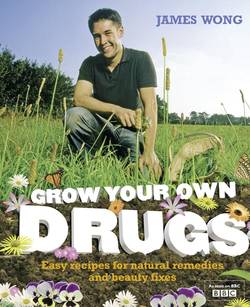Читать книгу Grow Your Own Drugs: A Year With James Wong - James Wong - Страница 6
2 THE BASICS: GROWING AND MAKING
ОглавлениеIf some glossy cosmetics ads with their slick marketing spiel are to be believed, the makers of natural remedies must trek up the Amazon to find the rarest botanical ingredients, then prepare them in state-of-the-art laboratories belonging to huge Swiss institutes. So it is entirely understandable why so many people are daunted just by the idea of making home remedies. Fortunately, the romantic stories of marketing men, though they might make for beautiful TV adverts and entertaining reading, are very far from the truth.
More than three-quarters of the world relies on plants as the primary form of healthcare, and plant-based remedies have evolved as cheap, simple and easy-to-prepare solutions for people with very little time, resources or money. It is for this reason that I passionately believe plant-based remedies to be as relevant for our society as they are for shamans in the Andes or farmers in Malaysia. The average kitchen in the United Kingdom is infinitely better equipped than my gran’s back in Borneo, where she would effortlessly whip up all manner of lotions and potions in mere minutes, from what were effectively the hedge trimmings out of the back garden. With mod cons like blenders, microwaves and dishwashers at our disposal, it is much quicker and easier for us to rustle up a recipe – no matter how domestically challenged we think we are. In this section I reveal a few tricks of the trade, which I hope will help demystify the growing side of things, and a couple of simple rules to ensure flawless concoctions every time.
It never fails to surprise me how many people seem utterly convinced they have some kind of superhero-like ability to kill plants. Please don’t worry: pruning techniques needn’t be perfect, and cultivation doesn’t need to be absolutely spot on to get a plant to thrive well. In fact, to my mind the single most important rule in gardening, and one which is hardly ever mentioned, is that it is in a plant’s own interest to grow. Plants have been around for millions of years without any help from humans and have independently evolved a huge range of ingenious strategies to cope with even the harshest conditions. As long as you place them in an environment that roughly matches the conditions they originally come from, they honestly are quite happy to take care of themselves – with little or no intervention from green (or not so green) fingers. In this section, I outline exactly how to identify your garden type – trust me, this is much more straightforward than it sounds! – and which plants are most likely to succeed in the conditions you have. If you get these two bits right, that’s half the battle won.
As for herb plants, it’s a wonderful coincidence that these happen to be the easiest of all plants to grow. Having originally evolved as weedy species that spring up on any piece of disturbed ground, they are perfectly happy to put up with all kinds of punishment, with many thriving on pure neglect.
If you’ve ever planted mint, lemon balm or feverfew, for example, you’ll know that as soon as they’re in the ground they spread rampantly, colonizing any bare earth and even cracks in the pavement. They won’t need anything more than the occasional hacking back, giving you limitless handfuls for flavouring foods, concocting remedies and crafting cosmetics.
To transform your backyard clippings into a whole range of natural remedies, I also hope to demystify words like ‘tincture’, ‘decoction’ and ‘salve’, showing you how these can all be knocked up with only a few minutes’ effort, with results rivalling anything to be found on the shelves of even the most upmarket health food shops and cosmetics counters.
